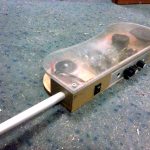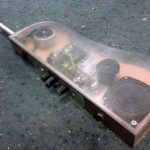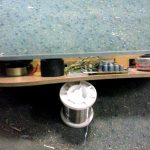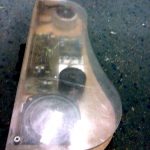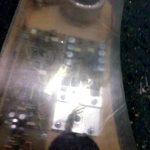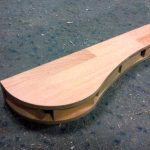In 2017 I decided to finish building two pieces of “classic” theremin by using the two printed circuit boars that i etched five years ago. The circuit is basically the “etherwave” theremin by Robert Moog. The prototype was built and tried successfully at that time – but then the time somehow evaporated. So this now is the psycho-disciplinary action: finishing what was started – and: something to do in-between.
I was able to do the instrument building in the workshop of Cirkulacija 2 – with all the nice machinery (and people) around.
Theremin is one of the first electronic musical instruments – from the start developed with the music in mind. It was devised by Lev Termen in the 1920s. Further historical information is elsewhere.
The design seems to be important with this kind of builds, since there is a number of existing products around. It is about identity – the difference.
The form is clearly that of a half of the violin. Theremin was first played by trained violinists. The playing is also quite resemblant to that of a violin- especially the vibrato. And: the sound that is preferred is very similar to that of a violin. Of course, theremin is not a violin, and the cutoff side is there for all the knobs and buttons. The prolonged aluminium tube is not a neck of the violin, but it is the mounting point for the pitch antenna. The design is the mirror image of the most theremin designs: the pitch antenna is on the left and the volume antenna is on the right (hand on the loudspeaker turns the volume down).
Electronic part are:
– theremin board
– small power amplifier board with output transformer and loudspeaker to provide power below 7W
– power line transformer
– still to come: the addition of digital interface that outputs MIDI
The small output transformer was used to electrically isolate the theremin from other equipment – when connected to a audio mixing desk or the likes.The power line transformers that i have are rated 48V/ 0.3A – so a step down transformed for a loudspeaker was anyway needed.
Mechanical parts are:
– front plate aluminium L profile to hold the theremin PCB
– box made of cheap fake parquet boards cut with CNC2 router
– transparent plexiglass cover cut with CNC2 router (still needs the opening holes for the loudspeaker sound)
– another plexi will be thermo-formed with the use of a form already prepared – this will be the sides of the violin/ theremin body
– the stand (theremin needs to be isolated from proximity of other grounded equipment – and persons)
will continue…
